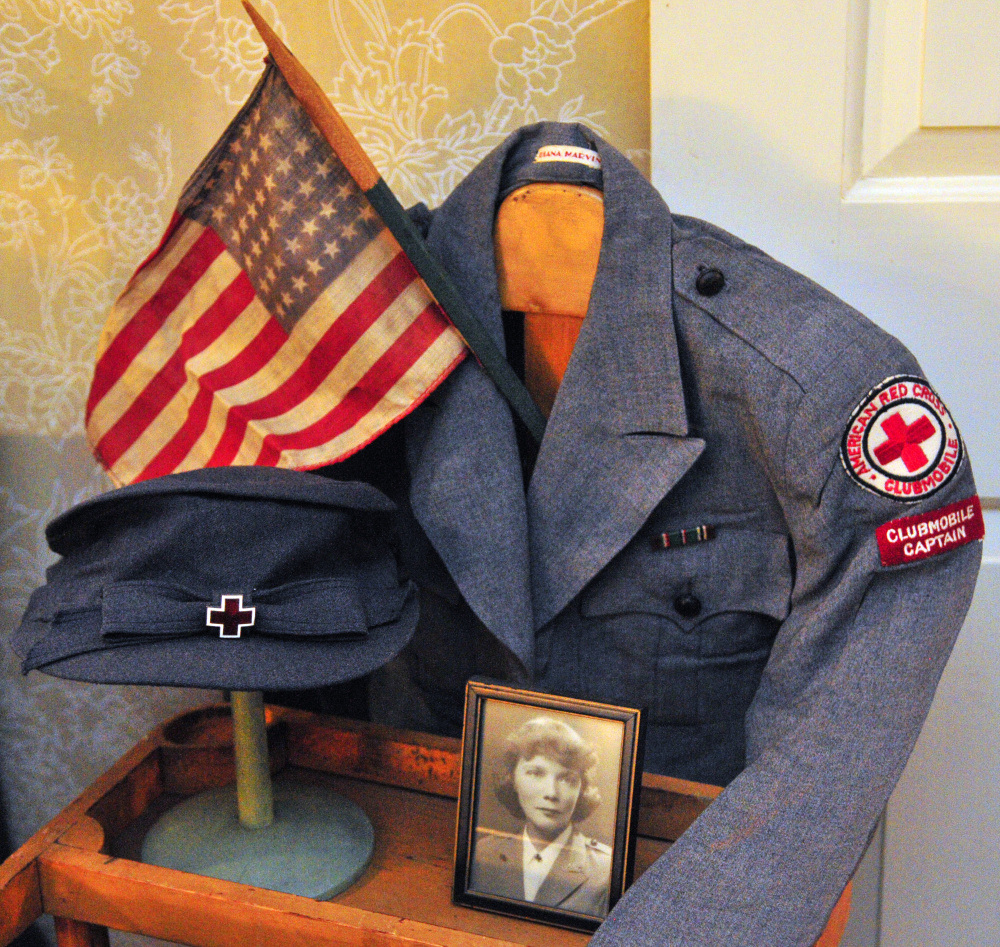HALLOWELL — Sometimes history isn’t written so much by the winners; it’s written by the people who write – letters, journals, shopping lists and inventories – and who keep those documents for generations.
On Wednesday, Veterans Day, a slice of the military history of the Vaughan family, whose roots in Hallowell reach back to the late 1700s, was unfolded at a special presentation at the Vaughan Homestead overlooking the Kennebec River. The wartime recollections, culled from more than 25,000 documents that have been tucked away in trunks, boxes, drawers, closets and back rooms at the homestead and given voice by homestead curators and volunteers, reveal an intimate slice of family life in times of conflict.
“These bits and pieces begin to fit together like pieces of a jigsaw puzzle,” Ron Kley said. Kley and Jane Radcliffe are contract curators who have been working part time with the collection in the homestead over the course of a decade.
William Manning Vaughan was a boy when his father, William Oliver Vaughan, received notice to muster the Hallowell Militia Company in September 1814 to travel down to Wiscasset to assuage coastal residents’ fears of a British invasion. The company stayed two weeks and saw no action, and the war ended three months later. The younger Vaughan recounted the incident in his journal decades later, including his recollections of watching the subsequent groups of soldiers pass the homestead on the way to the coast and his own efforts assembling the cartridges for the muskets.
William Manning had moved his family to Boston and had taken a job with the J.J. Adams Brush Factory by the time the Civil War broke out. He sponsored James Leary, an Irish immigrant and factory worker, to be a soldier in the Union Army, outfitting him with a uniform and a gun. The two corresponded regularly throughout the war with Leary sending back details from his engagements in the Battle of Williamsburg and the second Battle of Bull Run. By then his uniform was in tatters and he was barefoot.
Documents also show a Vaughan family cousin, John Otis, fought in the Civil War, but for the Confederacy.
The war also drew in William Manning’s son Benjamin, who gave up his posting on Cape Cod for one that would see more action. A week before Gen. Robert E. Lee surrendered at Appomattox, Benjamin was wounded in the Battle of Petersburg. The family archive contains a telegram from Benjamin’s father-in-law announcing Benjamin’s death, and a telegram received the very next day, from Benjamin, proclaiming his survival.
During World War I, Benjamin’s brother, William Warren – too young to serve in the Civil War – established a Victory Garden in Vaughan Woods’ Old Pasture to support the war effort at home, detailing the painstaking efforts needed to keep the crops protected from pests. He held a fundraiser for the American Red Cross, which was described in preserved clippings from the Kennebec Journal. His son, Samuel, enlisted in the military and served in France.
Samuel’s sister, Mary Vaughan Marvin, kept up correspondence with her friends in England in the early years of World War II, sending care packages containing items that were hard to find in England – bobby pins, stockings, even lipstick.
Her daughter, Diana, signed up for the Red Cross and was sent to England for much of the war. Her journals recount the thousands of doughnuts dispensed, the cold and wet weather, and the devastation she saw in Europe following D-Day. Her Red Cross uniform remains at the homestead.
“We had started documenting the artifacts in the house,” Radcliffe said, “when Ellen Gibson, the executive director, walked in with a box of papers.”
That started an effort to preserve the papers and build a database to track them all.
“Jane and I are so familiar with the family stories that we can read something and understand how it relates to something else,” Kley said.
But sometimes an outside assist is required. Kley said they came across a receipt in the papers of the original Vaughan – Charles, who was an uncle to William Oliver – from the Charleston Naval Shipyard for a mast from a tree most likely cut from Vaughan land for one of six frigates under construction at the time. Among them was the USS Constitution, the oldest commissioned ship in the U.S. Navy and still stationed in Boston. It earned its nickname, Old Ironsides, in the War of 1812.
A referral from a friend put Kley in touch with a person from the USS Constitution Museum, which had a receipt from a Charles Vaughan for a mast that in fact was destined for the Constitution.
“That’s the way many of these stories come together,” Kley said.
Jessica Lowell can be contacted at 621-5632 or at:
jlowell@centralmaine.com
Twitter: JLowellKJ
Copy the Story LinkSend questions/comments to the editors.



Success. Please wait for the page to reload. If the page does not reload within 5 seconds, please refresh the page.
Enter your email and password to access comments.
Hi, to comment on stories you must . This profile is in addition to your subscription and website login.
Already have a commenting profile? .
Invalid username/password.
Please check your email to confirm and complete your registration.
Only subscribers are eligible to post comments. Please subscribe or login first for digital access. Here’s why.
Use the form below to reset your password. When you've submitted your account email, we will send an email with a reset code.